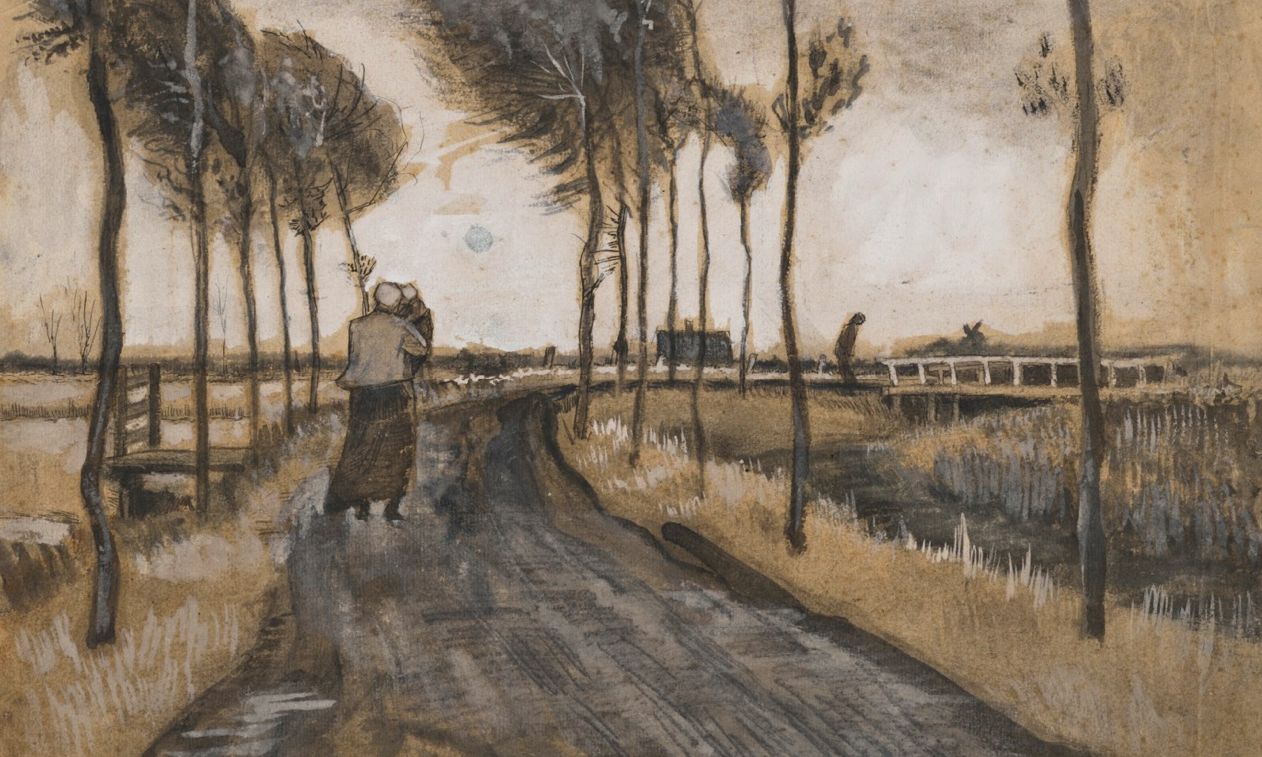Van Gogh’s Landscape with Walking Woman (Landschap met Lopende Vrouw) (April-May 1883). Courtesy of Christie’s
Charles Obach, the gallery boss who sacked his assistant Vincent van Gogh for being clumsy at dealing with customers, eventually sold two of his drawings, we can reveal. These included Landscape with Walking Woman, which was auctioned at Christie’s in London on 2 March for £1.7m.
Christie’s tracked down the provenance of the first drawing, finding that it had been owned by the Munich-based Galerie Heinemann in 1910. It was then bought by Obach & Co in London, for £25. By this time Charles Obach had retired from the day-to-day running of the gallery, but he remained its owner.
Photograph of Charles Obach by Paul Stabler (mid-late 1870s). Courtesy of National Portrait Gallery, London
Van Gogh, at the age of 20, had been sent to England in 1873 to work for the French-owned Goupil gallery. Obach then ran its London branch, in Covent Garden. Born in Stuttgart in 1841, he was the son of a Swiss artist, Kaspar Obach.
Obach was kind to Van Gogh after his arrival in London, inviting him for a Sunday family excursion to Box Hill, in Surrey, and later for a Christmas meal at their home in Brixton Road.
Unfortunately Van Gogh turned out to be an awkward employee, lacking tact. On two occasions Obach helped arrange for him to be temporarily transferred to the gallery’s head office in Paris, hoping that a change would improve his performance. But the situation did not improve, and in January 1876 Van Gogh was sacked by the Paris directors, presumably with the approval of Obach.
Five years later, after serving as an evangelist among the coal miners of the Borinage, in Belgium, Van Gogh changed tack and decided to become an artist. Landscape with Walking Woman (April-May 1883) dates from his later stay in The Hague. The ink drawing, heightened with white, depicts a woman holding an infant on a tree-lined road, approaching a bridge.
Despite Van Gogh’s efforts, he only managed to sell one identified painting by the time of his death in 1890. As for Obach, in 1884 he had left Goupil to set up his own gallery in London, Obach & Co, specialising in contemporary Dutch and French art.
After having bought Landscape with Walking Woman in December 1910, Obach & Co sold it eight months later to the distinguished Berlin collector Otto Gerstenberg, in whose family it remained until 1996. That year it was sold at Christie’s, fetching £155,000.
Van Gogh’s Weeping Woman (March 1883). Courtesy of Art Institute of Chicago
Our inquiries show that Obach & Co also bought a second Van Gogh in 1910, this time paying £5. Weeping Woman (March 1883) depicts Vincent’s lover Sien Hoornik as a grieving figure seated on a basket. In 1947 this fine drawing was donated to the Art Institute of Chicago.
And what were Obach’s memories of his young Dutch assistant? Until now nothing appeared to have been recorded. But although the connection has not been made before, the art historian Roger Fry—who organised the Post-Impressionist exhibition in London in 1910—seems to have talked with the elderly Obach.
In Fry’s 1926 book Transformations, referring to Van Gogh, he wrote: “There may very well be some picture dealers still left in Bond Street who remember a young Dutch assistant at the Goupil Galleries who came every day to work, like everyone else in those days, in a top hat”.
Fry had discussed Van Gogh with someone who remembered him, although he was discreet and did not name the dealer. His source, almost certainly Obach (whose gallery was at 168 Bond Street), recalled the Dutchman: “He used to be such a modest, retiring young man”.
These may be admirable qualities, but perhaps not those of a successful art dealer. Fortunately Van Gogh deployed his very considerable talents elsewhere.
Other Van Gogh news:
Van Gogh’s A Pair of Lovers (Eglogue en Provence) (March 1888). Courtesy of Sotheby’s
Martin Bailey is the author of Van Gogh’s Finale: Auvers and the Artist’s Rise to Fame (Frances Lincoln, 2021, available in the UK and US). He is a leading Van Gogh specialist and investigative reporter for The Art Newspaper. Bailey has curated Van Gogh exhibitions at the Barbican Art Gallery and Compton Verney/National Gallery of Scotland. He was a co-curator of Tate Britain’s The EY Exhibition: Van Gogh and Britain (27 March-11 August 2019).
Bailey has written a number of other bestselling books, including The Sunflowers Are Mine: the Story of Van Gogh's Masterpiece (Frances Lincoln 2013, available in the UK and US), Studio of the South: Van Gogh in Provence(Frances Lincoln 2016, available in the UK and US) and Starry Night: Van Gogh at the Asylum (White Lion Publishing 2018, available in the UK and US). Bailey's Living with Vincent van Gogh: the Homes and Landscapes that Shaped the Artist (White Lion Publishing 2019, available in the UK and US) provides an overview of the artist’s life. The Illustrated Provence Letters of Van Gogh has been reissued (Batsford 2021, available in the UK and US).
• To contact Martin Bailey, please email: [email protected]. Please kindly refer queries about authentication of possible Van Goghs to the Van Gogh Museum.
Read more from Martin's Adventures with Van Gogh blog here.

